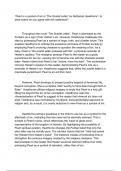“Pearl is a symbol of sin in ‘The Scarlet Letter’ by Nathaniel Hawthorne”- to
what extent do you agree with this statement?
Throughout the novel “The Scarlet Letter”, Pearl is dismissed by the
Puritans as a sign of her mother’s sin. However, Hawthorne challenges this
idea by portraying Pearl as a symbol of hope, truth, and a better future. This
enables Hawthorne to criticise the excessive strictures of Puritan society by
employing Pearl’s evolving character to question the meaning of sin. As a
baby, Pearl is “the scarlet letter endowed with life”, a physical reminder of
Hester’s adultery. The metaphor portrays Pearl to the reader as a godly
punishment for her sin, causing her to become one with the shameful scarlet
letter. Hester claims that Pearl is her “torture, none the less!”. The exclamation
conveys Hester’s passion to the reader, demonstrating Pearl’s role as a
reminder of Hester’s sin. Hawthorne suggests that, whilst the scarlet letter is a
manmade punishment, Pearl is an act from God.
However, Pearl develops to present positive aspects of American life,
beyond corruption. She is a hopeful child “worthy to have been brought forth in
Eden”. Hawthorne utilises religious imagery to imply that Pearl is a holy gift,
lifting the beyond the sin of her conception. Hawthorne uses the
characterisation of Pearl to suggest to the reader that inherent sin does not
exist. Hawthorne was motivated by his liberal, transcendentalist approach to
religion and, as a result, it is overly reductive to view Pearl as a symbol of sin.
Hawthorne portrays goodness in the child to use her as a symbol for the
aftermath of sin, indicating that one need not be eternally damned. This is
evident in Pearl’s name, which references the “pearl of great price”,
representative of the kingdom of heaven. By highlighting the possibility of
Pearl spiritual aviation, Hawthorne changes the Puritan belief that only the
elect elite may be morally pure. The narrator claims that the “child had saved
her [Hester] from Satan’s snare”. The sibilance creates a foreboding tone to
strengthen the ominous imagery created by the religious metaphor. This
demonstrates to the reader that Hester would be damned without her child,
portraying Pearl as a symbol of salvation, rather than of sin.
, Moreover, Pearl’s principle role is to expose the truth in the society
surrounding her, and she comes to symbolise this enlightenment. Pearl “threw
one of the prickly burrs at the Reverend… The sensitive clergyman shrunk…
from the light missile”. The burrs symbolise shame, as a result of the Puritan
rejection of everything related to nature. This is emphasised by the metaphor
of the “missile”, which heightens the reader’s awareness of Dimmesdale’s
guilt. Through this, Pearl links Dimmesdale to Hester and the scarlet letter
exposing him as her father. As a result, Pearl matures outside of her mother’s
sin to represent the exposure of truth, as she covers the hypocrisy of the
Puritan leaders. She acts as a vessel for Hawthorne’s criticism of “the little
Puritans, being of the most intolerable brood”. The superlative highlights the
flaws of Puritan society, suggesting that it is the townsfolk, rather than Pearl,
who are the embodiment of sin. Hawthorne uses Pearl's suffering to highlight
her innocence, not her guilt, as a means of criticising the intolerance used as
the basis for colonial American society.
Furthermore, most importantly, Pearl symbolises the future and,
therefore, cannot be held as a symbol for the sins of the past. Dimmesdale
states that the child is only held responsible to the “freedom of a broken law”,
a paradox in a society whose strict confines ensure punishment for any lack of
compliance. This displays Pearl's inability to transcend the rules of Puritanism
to the reader, underlining her capacity to exist outside of its rigid definition of
sin. This freedom allows Pearl to undermine the very definition of sin,
symbolising the start of a new cultural and religious movement in colonial
America, where she may represent freedom from the judgement of oppressive
religion and attitudes towards sin.
Ultimately, Pearl is “as if she had been made afresh… must perforce be
permitted to live her own life, without her eccentricities being reckoned to her
for a crime”. The simile demonstrates the modernity represented by Pearl,
cutting her ties to her mother’s sin. The alliteration conveys an assertive tone
to the reader, displaying Pearl's determination to be free from the past, and
the allusion to crime and punishment underscores how Pearl will not be
confined by the crime of her birth. Pearl is portrayed by Hawthorne in this
manner to highlight how she has matured beyond the circumstances of her
birth, evolving to discard her connection to sin and embody the hope of an
improved, more liberated future.




